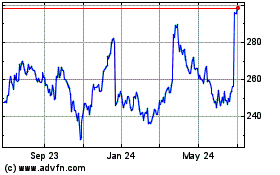Delivery Wars Hurt FedEx's Profit -- WSJ
December 18 2019 - 3:02AM
Dow Jones News
By Paul Ziobro
This article is being republished as part of our daily
reproduction of WSJ.com articles that also appeared in the U.S.
print edition of The Wall Street Journal (December 18, 2019).
FedEx Corp. cut its earnings targets for the fourth time in
2019, as the delivery giant struggles to adapt to a world where
fewer packages are being flown around the globe and more are being
delivered to people's homes from warehouses.
Profit has been sapped by a global slump in air shipments --
FedEx's core business -- and a surge in e-commerce deliveries to
residences -- a service the company is expanding at considerable
cost. The challenge has become acute as Amazon.com Inc. flips from
FedEx customer to formidable competitor.
On Tuesday, FedEx executives said the company had experienced
higher-than-expected expenses in the quarter that ended on Nov. 30
and cautioned costs would be elevated during the peak shipping
season now testing its limits. The company plans to take new steps
to rein in spending, including grounding aircraft, eliminating some
international flights and restricting hiring.
"We continue to be in a period of challenges and changes," FedEx
founder and Chief Executive Fred Smith said on a conference call.
He cited "a significant bow wave of expenses to handle volumes that
will largely fall" in the next quarter and a drag on the industrial
economy from trade disputes and tepid business-to-business
shipping.
FedEx shares, which were trading above $250 last year, fell more
than 6% in late trading Tuesday to around $153.
For its just-ended fiscal second quarter, FedEx posted a 40%
drop in profit and a 3% decline in revenue. It continues to deal
with the loss of Amazon's shipping contracts, which totaled $900
million in annual revenue, and a slump in global trade that has
damped demand for air shipments. FedEx said the pricing environment
is more competitive as well.
Rival United Parcel Service Inc. has capitalized on FedEx's
cutting ties with Amazon. UPS has spent heavily in recent years to
expand and automate its network to handle more online orders. In
recent quarters, it has significantly expanded its air shipments to
carry more packages, including from Amazon. In October, UPS posted
higher quarterly profit and revenue, and backed its earnings
targets for the year.
Both FedEx and UPS are absorbing higher costs in the U.S. as
they modernize sorting centers and shift to seven-day residential
delivery, not just during the holidays but year round. FedEx is
also beginning to keep in its network more of the packages it had
sent to the U.S. Postal Service for last-mile delivery.
The goal is to shift FedEx's delivery network, designed
primarily for shipments between businesses, to one that can deliver
more individual packages to residences to capitalize on the
relentless growth of online shopping.
The latest quarter shows that the changes FedEx is making to its
Ground network "are costing them more than they had realized," said
Satish Jindel, president of the parcel research firm SJ Consulting
Group Inc.
FedEx executives admitted that they underestimated how much it
would cost to expand to seven-day delivery, which started in early
November. "Clearly, we didn't do the greatest job of forecasting
our cost," Mr. Smith said.
Finance chief Alan Graf added that FedEx has had to pay
higher-than-expected wages in some areas given the tight labor
market.
Both FedEx and UPS have acknowledged some problems making all
their deliveries during the holiday season. They said winter storms
slowed operations in some areas during Cyber Week, the busy
shipping period after Thanksgiving. They are also facing a
truncated calendar this year with six fewer days between
Thanksgiving and Christmas.
For FedEx, this calendar shift pushed Cyber Week into the
company's fiscal third quarter. That added costs to the second
quarter without the revenue bump.
Amazon hasn't just stopped using FedEx's service. It is also
ramping up its own delivery capabilities, including leasing cargo
planes and buying thousands of vehicles. Analysts estimate Amazon
will handle nearly half of its own package deliveries this holiday
season.
This week, Amazon prohibited its third-party sellers from using
FedEx's Ground network for Prime shipments citing poor delivery
performance. The online retailer said it won't allow merchants to
resume using FedEx for such orders until service improves.
For its second quarter, FedEx reported a profit of $560 million,
compared with net income of $935 million a year earlier. Excluding
integration expenses and aircraft impairment charges, per share
earnings were $2.51 -- below Wall Street's expectations.
Revenue fell 3% to $17.3 billion, including a 5% decline in its
Express segment and a 3% increase in its Ground business. Analysts
polled by FactSet expected $17.6 billion in quarterly revenue.
For the current fiscal year, FedEx is now forecasting per share
earnings of between $10.25 and $11.50 before pension accounting
adjustments, compared with its forecast of $11 to $13 issued in
September.
Write to Paul Ziobro at Paul.Ziobro@wsj.com
(END) Dow Jones Newswires
December 18, 2019 02:47 ET (07:47 GMT)
Copyright (c) 2019 Dow Jones & Company, Inc.
FedEx (NYSE:FDX)
Historical Stock Chart
From Mar 2024 to Apr 2024

FedEx (NYSE:FDX)
Historical Stock Chart
From Apr 2023 to Apr 2024
